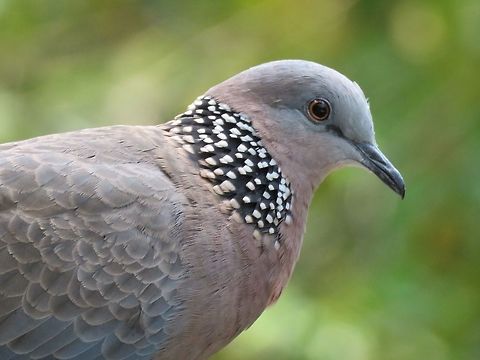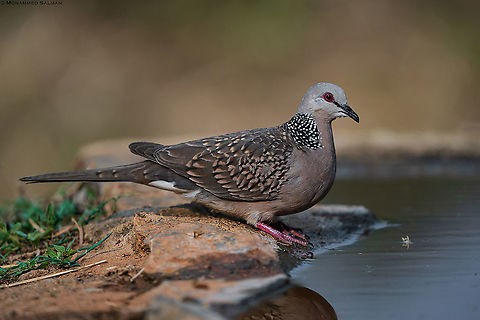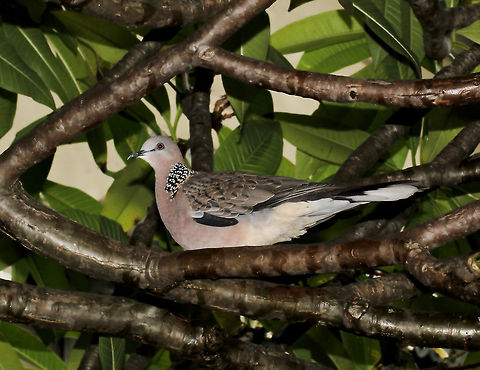
Appearance
The ground colour of this long and slim dove is rosy buff below shading into grey on the head and belly. There is a half collar on the back and sides of the neck made of black feathers that bifurcate and have white spots at the two tips. The median coverts have brown feathers tipped with rufous spots in the Indian and Sri Lankan subspecies which are divided at the tip by a widening grey shaft streak.The wing feathers are dark brown with grey edges. The centre of the abdomen and vent are white. The outer tail feathers are tipped in white and become visible when the bird takes off. Sexes are similar, but juveniles are duller than adults and do not acquire the neck spots until they are mature. The length ranges from 28 to 32 centimetres.
Abnormal plumages such as leucism can sometimes occur in the wild.

Distribution
The spotted dove in its native range in Asia is found across a range of habitats including woodland, scrub, farmland and habitation. In India it tends to be found in the moister regions, with the laughing dove appearing more frequently in drier areas. These doves are mostly found on the ground where they forage for seeds and grain or on low vegetation.The species has become established in many areas outside its native range. These areas include Hawaii, southern California, Mauritius, Australia and New Zealand.
In Australia, they were introduced in Melbourne in the 1860s and has since spread, but there is insufficient evidence that they compete with native doves. They are now found in streets, parks, gardens, agricultural areas and tropical scrubs in diverse locations in southern and eastern Australia from Eyre Peninsula in South Australia to Cape York in Queensland. The original populations appear to be "chinensis" and "tigrina" in varying proportions.

Behavior
Spotted doves move around in pairs or small groups as they forage on the ground for grass seeds, grains, fallen fruits and seeds of other plants. They may however take insects occasionally and have been recorded feeding on winged termites. The flight is quick with regular beats and an occasional sharp flick of the wings. A display flight involves taking off at a steep angle with a loud clapping of the wing and then slowly gliding down with the tail spread out.The breeding season is spread out in warm regions but tends to be in summer in the temperate ranges. In Hawaii, they breed all year round, as do all three other introduced species of doves. Males coo, bow and make aerial displays in courtship. In southern Australia, they breed mostly from September to January, and in the north in autumn. They nest mainly in low vegetation, building a flimsy cup of twigs in which two whitish eggs are laid. Nests are sometimes placed on the ground or on buildings and other structures. Both parents take part in building the nest, incubating and feeding the young. The eggs hatch after about 13 days and fledge after a fortnight. More than one brood may be raised.
The vocalizations of the spotted dove include cooing softly with a "Krookruk-krukroo... kroo kroo kroo" with the number of terminal "kroos" varying in the Indian population and absent in "tigrina", "chinensis" and other populations to the east.
The species has been extending its range in many parts of the world. Populations may sometimes rise and fall rapidly, within a span of about five years. In the Philippines, the species may be outcompeting "Streptopelia bitorquata". Their habit of flushing into the air when disturbed makes them a hazard on airfields, often colliding with aircraft and sometimes causing damage.
References:
Some text fragments are auto parsed from Wikipedia.